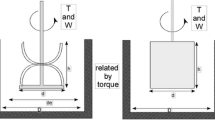Abstract
The paper proposes a new technique allowing the determination of thermal conductivity of liquids and polymer melts with unknown rheological behavior from batch mixer data; the mixing elements can have simple or complex geometries. The simple mixer is represented by an equivalent simple Couette with a cup and a bob having an effective hydrodynamic (or thermal) radius, and the true batch mixer is represented by two adjacent concentric cylinder viscometer. Using the universal internal effective radius, the thermal conductivity for four polymers was estimated from the batch mixer temperature–rotor speed and torque data. A good agreement was found with the values measured by transient line source method and those of the literature. Melt activation energy was calculated from torque–temperature batch mixer data, and the obtained values were found to be consistent with the values extracted from low-amplitude oscillatory shear experiments as well as with the available published data.





Similar content being viewed by others
References
Afonso IM, Hes L, Maia JM, Melo LF (2003) Heat transfer and rheology of stirred yoghurt during cooling in plate heat exchangers. J Food Eng 57:179–187
Ait-Kadi A, Marchal P, Choplin L, Chrissemant AS, Bousmina M (2003) Quantitative analysis of mixer-type rheometers using Couette analogy. CJChE 80:1166–1174
Antunes CF, Machado AV, Van Duin M (2009) Degradation of the rubber network during dynamic vulcanization of EPDM/PP blends using phenolic resol. Rubber Chem Technol 82:492–505
Bai Y, Sundararaj U, Nandakumar K (2011) Nonisothermal modeling of heat transfer inside an internal batch mixer. AIChE J 57:2657–2669
Bhadane PA, Tsou AH, Cheng J, Ellul M, Favis BD (2011) Morphology and continuity development in highly reactive nanoscale polymer blends. Polymer 52:5107–5117
Bousmina M, Faisant JB, Aït-Kadi A (1999) Determination of shear rate and viscosity form rotor speed and torque data in batch mixers. J Rheol 43:415–433
Bozarth MJ, Done D (1991) Calculating resin material properties for injection moldfilling software. In: ANTEC’91, pp 2431–2433
Cassagnau P, Bounor-Legare V, Fenouillot F (2007) Reactive processing of thermoplastic polymers: a review of the fundamental aspects. Int Polym Process 22:218–258
Filippi S, Madrigali L, Polacco G, Magagnini P, La Mantia FP, Acierno D (2006) Torque-rheometry investigation of model transreactions involving condensation polymers. I. Polyesters. Polym Eng Sci 46:139–152
Fradette L, Thomé G, Tanguy PA, Takenaka K (2007) Power and mixing time study involving a Maxblend ® Impeller with viscous Newtonian. J Non-Newton Fluids 85:1514–1523
Goodrich JE, Porter RS (1967) A rheological interpretation of torque-rheometer data. Polym Eng Sci 7:1–7
Hingmann R, Rieger J, Kersting M (1995) Rheological properties of a partially molten polypropylene random copolymer during annealing. Macromolecules 28:3801–3806
Inceoglu F, Ville J, Ghamri N (2011) Correlation between processing conditions and fiber breakage during compounding of glass fiber-reinforced polyamide. Polym Compos 32:1842–1850
Iza M, Bousmina M (2000) Non-linear rheology of immiscible polymer blends: step strain experiments. J Rheol 44:1363–1384
Iza M, Bousmina M, Jerome R (2001) Rheology of compatibilized immiscible viscoelastic polymer blends. Rheol Acta 40:10–22
Lacoste C, Choplin L, Cassagnau P, Michel A (2005) Rheology innovation in the study of mixing conditions of polymer blends during chemical reaction. Appl Rheol 15:314–325
Le Corroller P, Favis BD (2011) Effect of viscosity in ternary polymer blends displaying partial wetting phenomena. Polymer 52:3827–3834
Lobo H, Cohen C (1990) Measurement of thermal conductivity of polymer melts by the line-source method. Polym Eng Sci 30:65–70
Lobo H, Newman R (1990) Thermal conductivity of polymers at high temperatures and pressure. ANTEC 90:862–864
Lohfink GW, Kamal MR (1993) Morphology and permeability in extruded polypropylene/ethylene-vinyl alcohol copolymer blends. Polym Eng Sci 33(21):1404–1420
Pogodina NV, Cercle C, Averous L, Thomann R, Bouquey M, Muller R (2008) Processing and characterization of biodegradable polymer nanocomposites: detection of dispersion state. Rheol Acta 47:543–553
Ray SS, Vaudreuil S, Maazouz A, Bousmina M (2006) Dispersion of multi-walled carbon nanotubes in biodegradable poly(butylene succinate) matrix. J Nanosci Nanotechnol 6:2191–2195
Ray SS, Bandyopadhyay J, Bousmina M (2007) Effect of orgnaclay on the morphology and properties of PP/PBSA blends. Macromol Mater Eng 292:729–747
Rauwendaal Ch (2001) Polymer extrusion. Hanser, New-York, ISBN US:1-56990-321-2
Shahbikian S, Carreau PJ, Heuzey MC (2012) Morphology development of EPDM/PP uncross- linked/dynamically cross-linked blends. Polym Eng Sci 52:309–322
Scott CE, Joung SK (1995) Viscosity ratio effects in the compounding of low viscosity, immiscible fluids into polymeric matrices. In: Polyblends RETEC’95, pp 338–364
Teverovskiy M, Manas-Zloczower I, Elemans P (2000) Numerical simulations and experiments in a double-Couette flow geometry. Int Polym Process 15:242–254
Yu W, Zhou CX, Bousmina M (2005) Theory of morphology evolution in mixtures of viscoelastic components. J Rheol 49:215–236
Acknowledgement
The author acknowledges the support provided the Academy of Science and Technology.
Author information
Authors and Affiliations
Corresponding author
Rights and permissions
About this article
Cite this article
Bousmina, M. Determination of thermal conductivity of liquids and polymers from batch mixer data. Rheol Acta 51, 959–967 (2012). https://doi.org/10.1007/s00397-012-0654-6
Received:
Revised:
Accepted:
Published:
Issue Date:
DOI: https://doi.org/10.1007/s00397-012-0654-6




